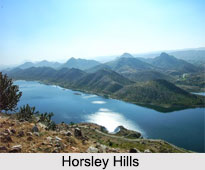 Located in the Madanapalle taluka of Chittoor district in the state of Andhra Pradesh, Horsley Hills is a series of hills at an elevation of 1,290 meters. Since it is a hill station, the place is also referred to as the Ooty of Andhra Pradesh and has a minimum temperature of 15° C and maximum of 30° C.
Located in the Madanapalle taluka of Chittoor district in the state of Andhra Pradesh, Horsley Hills is a series of hills at an elevation of 1,290 meters. Since it is a hill station, the place is also referred to as the Ooty of Andhra Pradesh and has a minimum temperature of 15° C and maximum of 30° C.
Etymology of Horsley Hills
There is a legend of a saintly old woman named Mallamma, who lived atop the Horsley Hills and was fed by elephants. Thus, the local name of the hill is Yenugu Mallama Konda. Another legend talks about the British collector named WD Horsley, who built himself a bungalow in the year 1850 to escape the heat waves from the plains during summer. Hence, the hill was named after him.
Flora and Fauna of Horsley Hills
The hills are well vegetated with a cooler climate, in contrast to the hot and dry surrounding. The native vegetation of the area has been replaced in some parts with dense growths of eucalyptus and plantations of exotic trees like gulmohar, allamanda, reeta, amla, blue gum and sandalwood. There is an exotic range of wildlife including the sambar deer, wild boar and sloth bear. There is a record of more than 133 species of birds namely the endemic yellow-throated bulbul, the black eagle and the white-rumped shama. The endemic toad called the Gunther"s toad or the Rock toad has been found here along-with a ground orchid called the Long-Leaf Diplocentrum was rediscovered here after nearly a century. Several species of lichen have also been documented from this region.
 Tourism in Horsley Hills
Tourism in Horsley Hills
Listed below is a list of major tourist attractions in and around the Horsley Hills:
Koundinya Wildlife Sanctuary: The habitat of Koundinya sanctuary is rugged with high hills and deep valleys with dry deciduous forests and thorny scrubs interspersed with trees. This is a wildlife sanctuary as well as an elephant reserve, with a large population of Asian elephants which migrated after 200 years from neighbouring regions. Other animals like chital, four horned antelope, sambar, mouse deer, hare, porcupine, wild boar, jungle cat, jackal, sloth bear, panther, jungle fowl and pea fowls are also found here. The best time to visit the Koundinya Wildlife Sanctuary is between the months of October and April. The winter months are ideal to watch the lake and the pools of the sanctuary are full of an assortment of vibrant migratory birds.
Talakona Waterfalls: Talakona is the highest waterfall in the Andhra Pradesh state and is also known for the Lord Siddheswara Swamy Temple located closest to the waterfall. The forests around the waterfall hosts rare and endangered species of animals like Slender Loris, Indian Giant Squirrel, mouse deer, golden gecko, panther, porcupine, chital and sambar. Endemic species like red sander and Cycas beddomeii like giant plants are also found in this region. The forest is mostly covered with sandalwood trees with some medicinal plants.
Gali Bandalu: Also known as the Windy Rock, Gali Bandalu is a rocky slope that derives its name from the gusty winds that blow nearly all day. The eastern and western viewpoints here are great places for sunrises and sunsets.
 View Point: Located at the highest summit that offers the great view of valleys, hillocks and dense forests, the View Point is one of the most popular places to visit in Horsley Hills. The best time to visit this spot is at sunset as it engulfs the whole valley in a golden glow.
View Point: Located at the highest summit that offers the great view of valleys, hillocks and dense forests, the View Point is one of the most popular places to visit in Horsley Hills. The best time to visit this spot is at sunset as it engulfs the whole valley in a golden glow.
Kalyani, the Eucalyptus Tree: Situated inside Van Vihar Park at the centre of Horsley Hills, this 150 year old tree stands at a height of 40 metres with a circumference of about 4.7 metres. The tree is hidden behind an old forest bungalow and is well protected with several tall Eucalyptus and other trees all around.
Other tourist attractions include the Horsley hills zoo, the Gangotri Lake, the Mallamma Temple and the Chennakesava Temple which is about 40 km from Horsley hills.
Visiting Information on Horsley Hills
The nearest airport is at Bangalore at a distance of about 144 km. The Madanapalle Road Railway Station which is 27 km away and the Tirupati railway station are the closest.



















